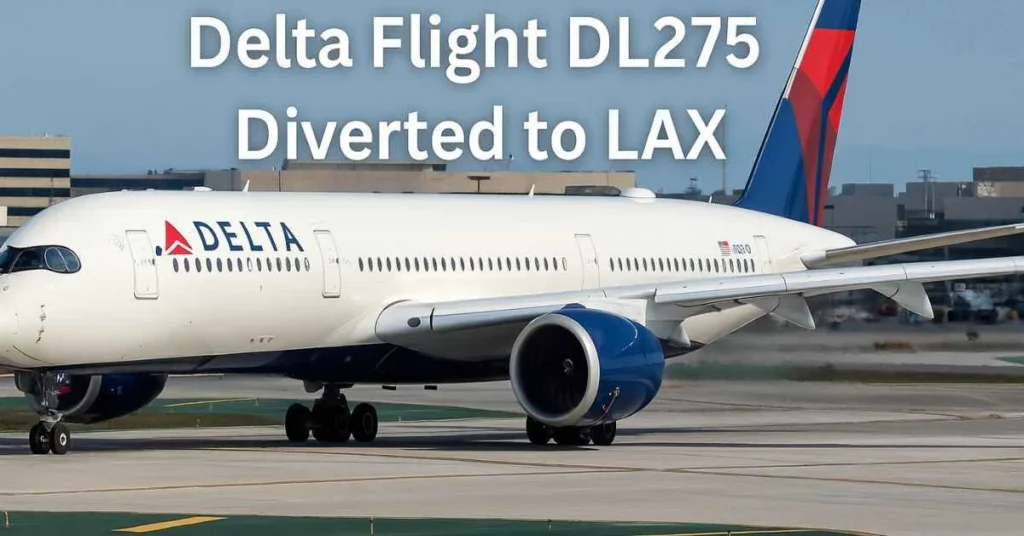Delta Flight DL275 recently made headlines when it was unexpectedly diverted to Los Angeles International Airport (LAX). Passengers on board were left puzzled and anxious, not knowing what exactly prompted the mid-flight change in plans. As travelers, we often take for granted the smooth operation of our flights. But incidents like this remind us that aviation can be unpredictable. What occurred during this flight? How did passengers react? Join us as we delve into the details surrounding Delta Flight DL275’s diversion and explore its implications for airline safety and emergency procedures.
What happened on delta flight dl275 diverted lax?
Delta Flight DL275 took off from New York City, bound for Tokyo. Shortly after takeoff, the aircraft encountered some technical issues that raised concerns among the crew.
As safety protocols dictate, the captain made the prudent decision to divert to Los Angeles. The plane changed course mid-flight, and passengers were informed about the unexpected landing.
The diversion was executed smoothly, with a focus on maintaining passenger safety above all else. Upon landing at LAX, emergency services were on standby as a precautionary measure.
Throughout this process, communication remained vital. Passengers received updates regarding their situation while preparing for an unscheduled stop in California.
Why was the flight diverted to LAX?
Delta Flight DL275 was diverted to LAX due to an emergency situation that required immediate attention. The flight, originally bound for its final destination, faced unexpected technical issues mid-air.
Upon detecting a potential malfunction, the pilots made the swift decision to reroute to Los Angeles International Airport. Safety is paramount in aviation; this choice reflects the crew’s training and commitment to passenger well-being.
The diversion allowed for a controlled landing environment where maintenance crews were on standby. This proactive approach ensured that any complications could be addressed promptly upon arrival.
Passengers were kept informed throughout the process, allowing them some reassurance amidst uncertainty. Such decisions highlight how vital communication is during unforeseen circumstances in air travel.
Reactions from passengers and crew members
Passengers aboard Delta Flight DL275 experienced a whirlwind of emotions during the unexpected diversion to LAX. Many voiced their concerns, unsure about what was happening and why they were suddenly changing course.
Some passengers took to social media, sharing updates with friends and family. They expressed anxiety but also relief that safety remained a priority. Conversations buzzed throughout the cabin as people exchanged theories about the situation.
Crew members handled everything with professionalism. Their calm demeanor reassured travelers, fostering an atmosphere of trust amid uncertainty. Flight attendants provided updates whenever possible, ensuring everyone felt informed and cared for.
As soon as it became apparent that diversions could happen due to unforeseen circumstances, many began discussing previous flights gone awry. The shared experience brought out empathy among passengers; strangers connected through mutual concern for each other’s well-being in this moment of chaos.
Impact on travel plans and delays
The diversion of Delta Flight DL275 to LAX disrupted travel plans for many passengers. Those on board faced unexpected delays, causing frustration and confusion. Connecting flights were missed, leaving travelers scrambling for alternatives.
Families separated by the flight’s change found themselves in distressing situations. Some had urgent commitments they needed to attend to, while others were just eager to reach their destinations.
Airlines often underestimate how these diversions ripple through a traveler’s itinerary. Each delay creates a chain reaction, impacting hotels and car rentals alike.
As news spread about the incident, travelers at LAX prepared for longer waits. The airport buzzed with uncertainty as people sought information on rebooking options and next steps.
Delta’s response and handling of the situation
Delta Airlines responded promptly to the diversion of Flight DL275. Crew members were quick to reassure passengers, providing updates and necessary information throughout the ordeal.
Upon landing at LAX, Delta activated its emergency response protocols. Ground staff was on hand to assist with rebooking flights and managing passenger needs. They offered accommodations for those affected by delays.
Communication played a key role in their handling of the situation. Delta kept passengers informed via announcements and notifications, ensuring everyone knew what steps were being taken next.
The airline’s commitment to safety remained evident during this incident. They prioritized getting everyone off the plane safely while minimizing disruption as much as possible amidst challenging circumstances.
Similar incidents in the past with Delta
Delta Air Lines has had its share of flight diversions over the years. In 2020, for instance, a flight heading to New York City made an unexpected stop in Richmond due to medical emergencies onboard. Such incidents highlight the unpredictability that can accompany air travel.
Another notable case occurred in 2018 when Delta Flight DL1494 was diverted to Denver after a passenger allegedly threatened crew members. These situations often escalate quickly and require swift action from airline staff.
While these events are alarming, they also showcase how airlines prioritize safety. Each diversion serves as a reminder of the challenges faced during flights and emphasizes the need for prepared emergency procedures. Passengers may find comfort knowing that protocols are in place to handle unexpected circumstances effectively.
How this incident highlights the importance of airline safety and emergency procedures
The diversion of Delta Flight DL275 to LAX underscores a critical aspect of air travel: safety protocols. Every flight is equipped with emergency procedures designed to protect passengers and crew during unforeseen circumstances.
Airlines invest heavily in training their staff on these protocols. In high-pressure situations, quick thinking can save lives. This incident serves as a reminder that preparation is key.
Passengers often take for granted the rigorous checks done before departure. Yet, events like this reveal the layers of safety measures that are in place but remain unseen until needed.
Furthermore, it highlights the importance of communication between pilots and air traffic control. Clear instructions ensure flights can be managed effectively even when emergencies arise.
This situation illustrates how vital it is for airlines to continually assess and improve their safety practices while keeping passengers informed throughout any unexpected developments.
Conclusion
Delta Flight DL275 recently made headlines when it was diverted to LAX. This unexpected turn of events stirred a mix of emotions among passengers and crew alike, highlighting the unpredictable nature of air travel.
The flight’s diversion stemmed from an unspecified issue that required immediate attention. Although the exact details were not disclosed, safety protocols ensured that all aboard remained as comfortable as possible under the circumstances.
Passengers shared their experiences on social media, many expressing concern but also gratitude for the professionalism displayed by the crew. Their quick response helped ease anxiety during a tense situation.
For those with connecting flights or other travel plans, this incident undoubtedly caused disruptions and delays. The ripple effect impacted schedules at various airports, requiring adjustments from both travelers and airline staff.
Delta Airlines addressed the situation promptly, assuring affected passengers they would be supported throughout their journeys. Communication was key; keeping everyone informed about updates helped alleviate some stress during an uncertain time.
Looking back at Delta’s history reveals similar incidents where safety took precedence over convenience. Each case serves as a reminder that airlines must prioritize passenger well-being above all else.
This recent event underscores how crucial reliable emergency procedures are in aviation. While flying can feel routine for frequent travelers, situations like Delta Flight DL275 remind us of inherent risks involved in air travel and reinforce trust in airline safety measures.
As travel continues to evolve post-pandemic, such occurrences will likely prompt conversations around improvements in aviation standards and customer care policies moving forward.


